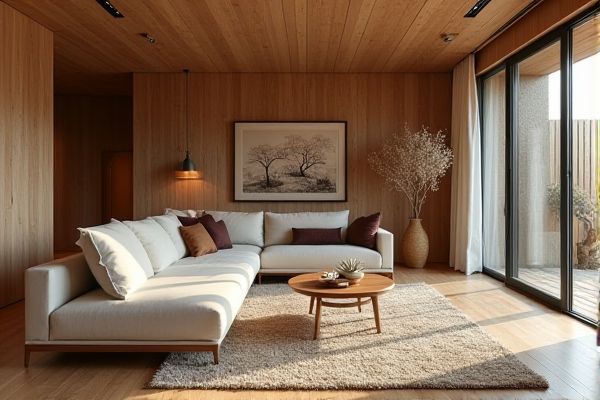
Polywood is a synthetic material known for its durability, weather resistance, and low maintenance, making it ideal for outdoor furniture that withstands harsh conditions. Acacia wood offers natural beauty with its rich grain and warmth but requires regular upkeep to prevent weathering and deteriorating; explore the rest of the article to determine which option suits your outdoor space best.
Table of Comparison
| Feature | Polywood | Acacia |
|---|---|---|
| Material Type | Recycled plastic composite | Natural hardwood |
| Durability | Highly durable, weather-resistant | Durable but susceptible to weather damage |
| Maintenance | Low maintenance, no sealing needed | Requires regular sealing and treatment |
| Appearance | Wood look, limited color options | Rich natural grain, warm tones |
| Eco-Friendliness | Made from recycled materials, sustainable | Renewable but involves tree harvesting |
| Cost | Moderate to high | Moderate |
| Use Cases | Outdoor furniture, decking, marine use | Furniture, flooring, cabinetry |
Introduction to Polywood and Acacia
Polywood is a durable, eco-friendly synthetic material designed to mimic the appearance of natural wood while offering resistance to weather, moisture, and insects, making it ideal for outdoor furniture. Acacia is a species of hardwood known for its rich, warm tones and natural durability, prized in furniture for its strength and resistance to decay. Choosing between Polywood and Acacia depends on your preference for low-maintenance synthetic materials versus the authentic look and feel of natural wood.
Material Composition and Manufacturing
Polywood is crafted from recycled high-density polyethylene (HDPE) plastic, offering durability and weather resistance through a process of compression and molding, making it low-maintenance and resistant to rot and insects. Acacia wood is a natural hardwood derived from fast-growing acacia trees, valued for its dense grain and natural oils that provide moderate resistance to moisture and decay, but it requires regular sealing or treatment to maintain longevity. The manufacturing of Polywood involves blending recycled plastics with UV stabilizers and pigments, while acacia furniture is traditionally cut, sanded, and finished with varnishes or oils to enhance its appearance and durability.
Durability and Longevity Comparison
Polywood offers exceptional durability due to its weather-resistant synthetic composition, making it highly resistant to moisture, insects, and UV damage, which ensures a longer lifespan in outdoor settings. Acacia wood, while naturally strong and dense, requires regular maintenance such as sealing or oiling to protect against weathering, rot, and insect infestations, which can affect its longevity. Overall, Polywood surpasses Acacia in durability and longevity, especially in harsh environmental conditions, providing a low-maintenance and lasting outdoor furniture solution.
Weather Resistance and Outdoor Suitability
Polywood offers superior weather resistance due to its synthetic composition, which resists moisture, UV rays, and temperature fluctuations better than natural wood like acacia. Acacia is naturally durable and can withstand outdoor conditions but requires regular sealing and maintenance to prevent cracking, warping, or fading over time. For long-term outdoor furniture, Polywood provides low-maintenance, consistent weatherproof performance that protects your investment in all climates.
Maintenance Requirements
Polywood requires minimal maintenance, needing only occasional cleaning with soap and water to maintain its appearance and durability, as it resists moisture, warping, and insects. Acacia wood demands more frequent upkeep, including regular sealing or oiling to prevent drying, cracking, and weather damage. The low-maintenance nature of Polywood makes it ideal for outdoor furniture exposed to varying climates, whereas Acacia requires consistent care to preserve its natural beauty and structural integrity.
Environmental Impact and Sustainability
Polywood, made from recycled plastic lumber, offers significant environmental benefits by reducing landfill waste and requiring no deforestation, making it a highly sustainable choice. Acacia wood, while renewable and biodegradable, involves harvesting from tropical forests, which can contribute to deforestation and habitat loss if not sourced responsibly. Choosing polywood supports a circular economy by utilizing recycled materials, whereas sustainable acacia relies heavily on certification programs like FSC to ensure responsible forestry practices.
Cost and Value for Money
Polywood furniture offers superior durability and low maintenance at a higher initial cost, making it a long-term investment for outdoor settings. Acacia wood tends to be more affordable upfront but requires regular upkeep to prevent weather damage and prolong its lifespan. You get better value for money with Polywood if you prioritize longevity and minimal care over the shorter-term savings of Acacia.
Aesthetic Appeal and Customization Options
Polywood offers a sleek, modern aesthetic with a smooth finish and consistent grain patterns, ideal for contemporary outdoor furniture designs. Acacia wood showcases rich, natural variations in color and texture, providing a warm, rustic charm that enhances traditional and eclectic styles. Customization options vary as Polywood allows for vibrant staining and shaping without compromising durability, while Acacia supports intricate carving and natural finishes, emphasizing authenticity and craftsmanship.
Common Uses for Polywood and Acacia
Polywood is commonly used for outdoor furniture, decking, and coastal applications due to its resistance to moisture, rot, and UV damage. Acacia is favored for indoor furniture, flooring, and decorative items because of its durability, attractive grain patterns, and natural resistance to wear. Both materials offer sustainable options but serve distinct purposes based on environmental exposure and aesthetic requirements.
Final Verdict: Which is Better for Your Needs?
Polywood offers exceptional durability, weather resistance, and low maintenance, making it ideal for outdoor furniture exposed to harsh elements. Acacia wood provides a natural, warm aesthetic with good strength but requires regular sealing to prevent weather damage. Choose Polywood for long-lasting resilience and Acacia for a more traditional, natural wood appearance suited to controlled environments.
 homyna.com
homyna.com